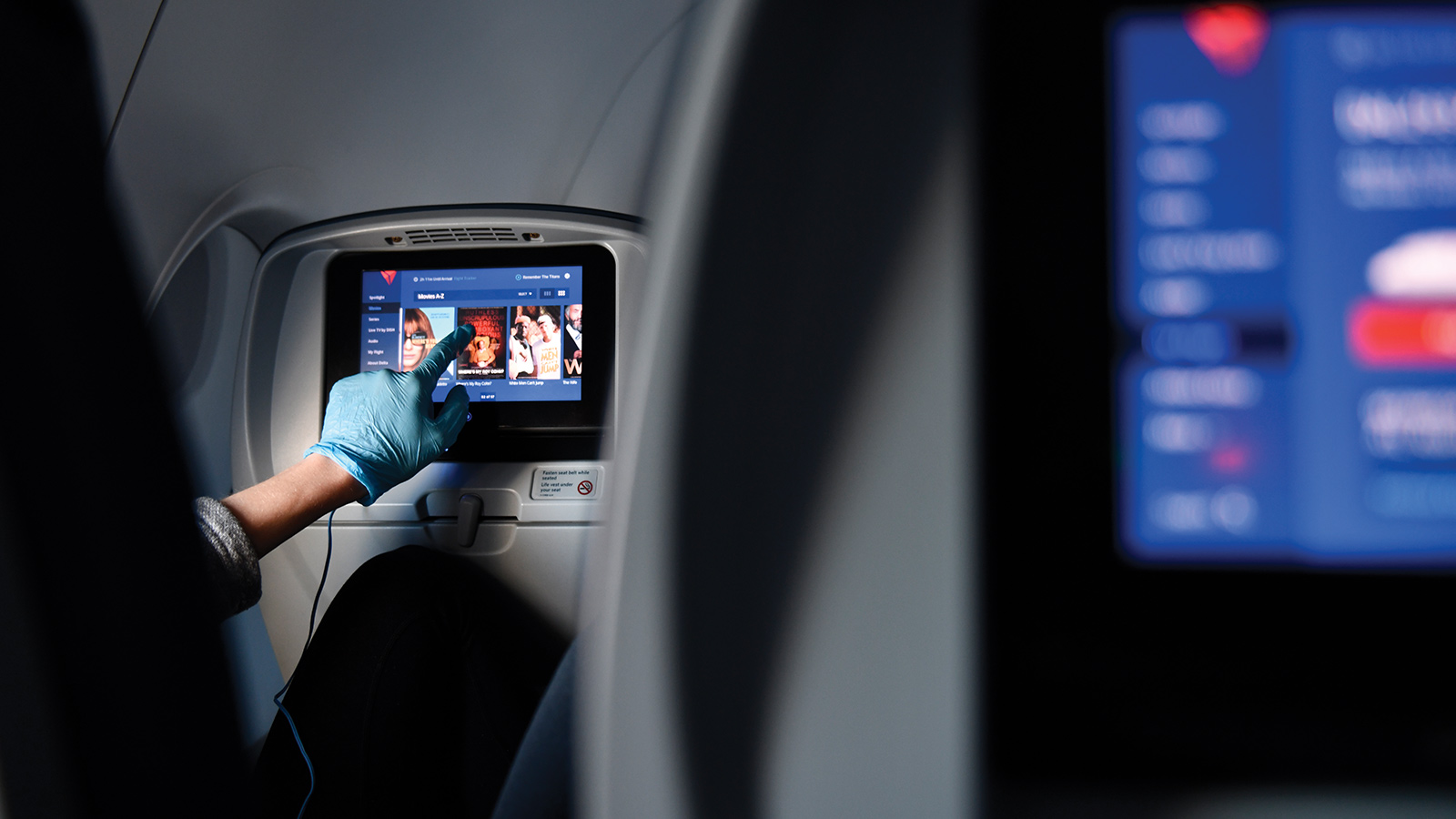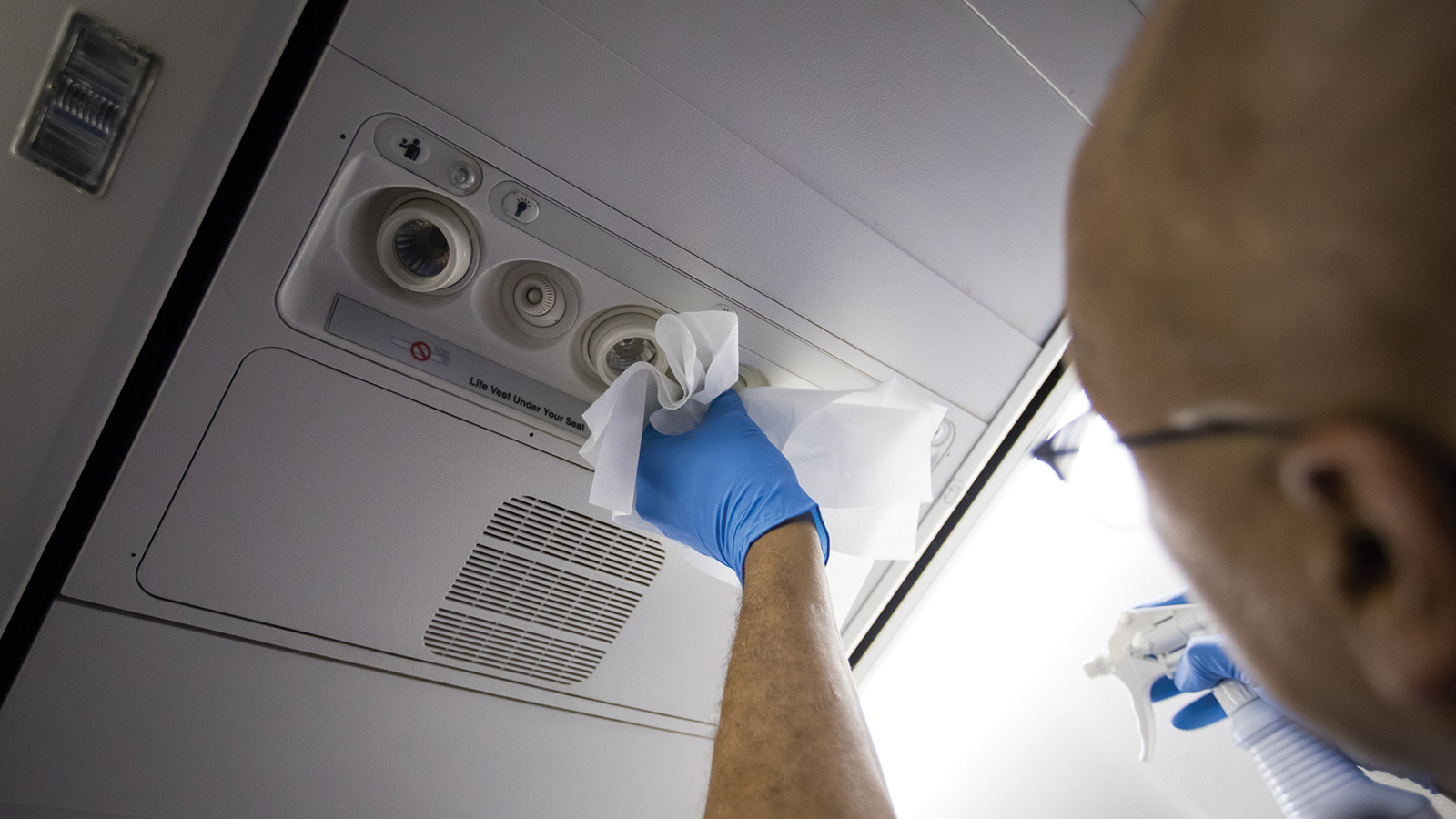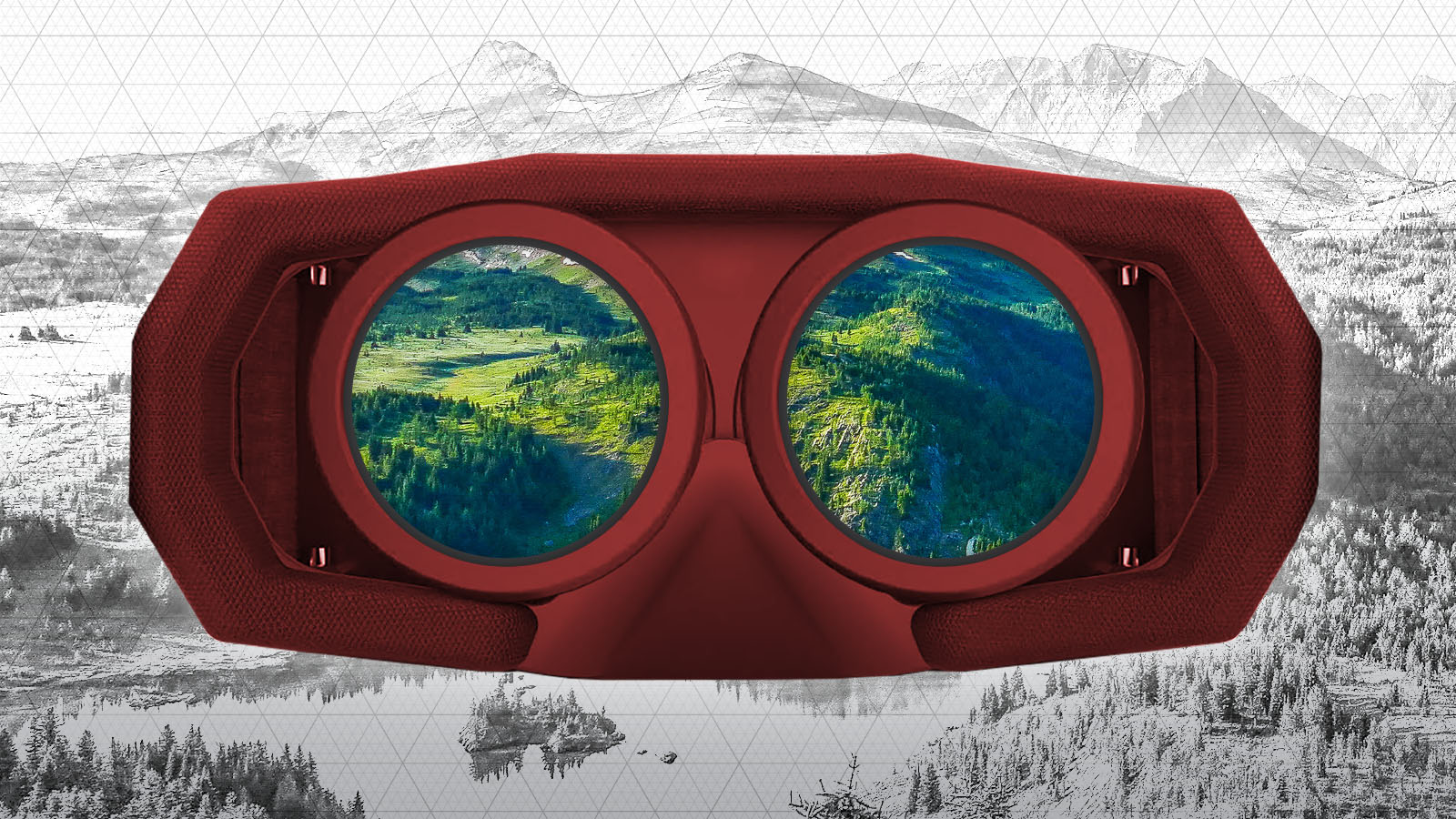Stay Up to Date
Submit your email address to receive the latest industry and Aerospace America news.
Technology that gives a person the sights, sounds and feeling of visiting a far-off destination may take a more prominent role because of the pandemic. But even those in the field of immersive technologies don’t expect a straight line to a world in which their wares satisfy our zest for travel the way an airline flight can. Sarah Wells finds out why.
With your afternoon coffee in hand, you set out for a stroll among the Faroe Islands’ pristine landscape of gently rolling hills and deep blue water. The lilting Danish accent of your just-out-of-sight tour guide follows you as you explore quaint villages and listen to the history of this rugged archipelago. Next, you decide to try something a little more exciting. You can almost feel the bracing cold air against your skin as you climb hand over hand up the steep face of Everest’s Hillary Step. Steadying your breath, you start to move up the mountain face — but the familiar knocking sound of a Slack notification interrupts the blowing wind.
With a sigh, you release your virtual reality goggles and end this session of Everest VR.
Virtual reality, augmented reality and holograms have long been dismissed as frivolous gaming devices or obscure medical tools, but for decades this technology has, in fact, been lying in wait for its chance to change our lives in a more substantial way.
This begs the question: Could the pandemic become the catalyst that launches immersive technology toward becoming a significant substitute for in-person air travel? The pandemic has certainly cut deeply into the airline industry and placed these two industries — air travel and immersive technology — at possible inflection points.
“[There is] a loss of trust and confidence in the ability to travel without being exposed to either a virus or some other affliction,” says Bob Mann, an aviation industry expert who runs R.W. Mann & Co., an airline management analysis and consulting service. “That’s something which has not in my 40 years of being involved with the industry ever occurred.”
What had been projected to be on-par travel records in January and February 2020 took a sharp turn in March, plunging 95% in just 30 days. Some airlines began expanding schedules in June, but Mann does not expect a rapid turnaround.
“This summer in the Northern Hemisphere may be the winter of tourism,” he says.
Enter VR and AR
Creative tourism groups are beginning to embrace virtual reality as an economic bridge to an era beyond the pandemic. Take the Faroe Islands: After the small Danish archipelago had to close its borders to visitors, the islands’ tourism board decided to offer immersive, at-home experiences to curb the tourism slump. Tour guides on the island donned GoPro-equipped safety helmets and began hosting virtual tours for visitors from around the world. Using only a phone or computer, these visitors could take 1-minute turns controlling where the tour guide went and what they saw. The game-like interface even let visitors make the tour guides jump or run.
This embrace should not be surprising. Even before the pandemic, “things were accelerating” in the immersive field, says Cathy Hackl, a futurist and author specializing in augmented and virtual reality.
Far from seeing a threat, airlines were exploring how they might incorporate virtual experiences into the travel market. Japan Airlines last year introduced “co-presence” robots from a company called Newme. These robots — resembling a moving pole with a tablet stuck on top — could serve as surrogates for sick or elderly family members who would, in a sense, travel with their families even if they could not do so in person. The tablet “faces” of these robots can tilt to get better views of tourist sites and can be driven by the remote family member for up to three hours at a little over 1.5 kph.
Of course, immersive technologies based on VR and AR were already seeing success in the tourism industry at places like Universal Studios. But, says Hackl, these uses were more of a sales tool than a true alternative to travel.
The challenges
Funding: As with other kinds of research and development, progress on immersive technologies has not been unscathed by the pandemic. With few people traveling, “marketing budgets are getting cut left and right,” and that means less funding for improving immersive technology, Hackl says.
Health: Then there is the issue of sanitation for shared devices, something that could stand in the way of large-scale adoption in the tourist industry any time soon. At the moment, goggles like Oculus or HTC Vive typically cost between $500 and $1,000 — cheap enough to be purchased by gaming enthusiasts but still prohibitively expensive for many. As a result, VR headsets have yet to become a must-have in home entertainment. While it’s possible to rent VR headsets or use them communally at indoor recreation centers like arcades, many consumers simply go without. But, for those who do choose to share headsets, this can create a major sanitation issue that Monika Bielskyte, a futurist specializing in immersive technologies and the design of non-dystopian futures, says could spell trouble for future, widespread adoption.
“One of the major issues [is] the way the headsets would press on your face like ski goggles with a nasty petroleum foam that is kind of impossible to disinfect,” says Bielskyte. “What you need is a redesign of the devices themselves using materials that can be very easily disinfected.”
But, in lieu of a full redesign, Hackl notes that more consumers buying individual headsets could negate the need to share dirty, communal headsets in travel and tourism settings. With this pull toward virtual realities and push away from communal products, Hackl predicts we could see a purchasing spike in personal headsets this year if covid-19 cases continue.
If that happens, the resulting virtual travel experiences may be something like what Megan Epler Wood, director of the Harvard T.H. Chan School of Public Health’s International Sustainable Tourism Initiative, experienced when she visited France’s historic cave painting sites.
“[VR] will be a tool to lower impacts [to fragile sites] and some of that can be seen already, say, in France or other really cutting-edge tourism destinations,” says Epler Wood. “I myself was in France two years ago … and they were already using that in fragile historical cave sites. They were not taking you into those; [instead] you were going into other areas that were beautifully done.”
Epler Wood says that through projections and VR goggles she was able to better learn how these drawings were made and how the ancient artists lived.
Virtual fatigue: Even playful virtual experiences, improved sanitation and personal headsets will not solve this obstacle, says Hackl.
If you have taken any number of calls over video chat during this pandemic, you are well aware of the physical and emotional drain that can come after ending a call. In some cases, this fatigue could stem from video lag or low-quality microphones interrupting us midsentence and making us repeat ourselves. Others have postulated it may be that virtual experiences lack a kind of feedback we expect from physical interactions, like an actor performing for an unmoved crowd. Or maybe it is because the moment we take off our headset or hang up our call we are exactly back where we were and have the cognitive weight of having exerted ourselves without having gone anywhere.
Whatever the reason, Hackl says that this cognitive dissonance is enough to make total virtual immersion an impossibility — for now at least. Hackl says these technologies are not going to shake aviation’s grasp on the travel industry anytime soon.
The destination
“Are we never going to travel?” Hackl ponders. She doesn’t have to think long: “I think we’re still going to travel; it’s human nature for us to want to go explore places.”
She expects that tourists will begin thinking more carefully about where and how often they travel, passing on hour-and-a-half flights to prioritize bucket list getaways like a family vacation abroad or Disney World. In the meantime, virtual experiences could help people better decide where they want to go and how to make the most of their trip when they get there.
This increased thoughtfulness could also help combat the strain of overtourism that can negatively impact local communities at big tourist hubs.
“The concept of sustainable tourism is really thinking about creating tourism at a destination that is going to ultimately have a benefit to the community,” says Jonathon Day, an associate professor in Purdue University’s School of Hospitality and Tourism Management. “Quite often tourism just happens to communities [and] often the community feels as though they aren’t in control of the growth that’s happening around them.”
Communities such as those in getaway destinations like Hawaii are driven by tourism and have felt a sharp impact as the number of tourists dried up during during the pandemic, but Day says an influx of travel back to these locations isn’t necessarily the solution. Instead, Day says that this could be a perfect opportunity to finally change the tide on how tourists interact with these communities.
“It’s really hard to change the wheel on a racing car when it’s going,” says Day. “But right now there is a moment in time when some of these destinations can be thinking ‘How can we prepare for demand to increase? How can we find the right balance between the benefits and the costs of tourism?’”
Day argues that VR and AR technology could enrich the experience tourists have when traveling and better educate them on the history and culture of the place they’re visiting. While this kind of learning could be experienced through VR alone, Day says that combining physical experiences with these augmented details could help tourists better connect with the communities they visit while still contributing to their economies.
Day and Epler Wood think immersive technology could take the pressure off fragile sites such as Epler Wood described in France. Solutions like this may become more common not only for sanitation and social distancing purposes but to better maintain these sites for antiquity as well.
In Bielskyte’s view, moving virtual and augmented reality devices in this direction would begin to shift the market away from gratuitous devices donned simply for distraction. Immersive technology would become an empathetic tool to help us better connect with our global community — something that feels particularly important now.
Echoing Hackl’s thoughts from before, Day says that the barrier standing between immersive technology and the tourism industry is not one of technology but rather one of creativity.
“The issue at the moment is a lack of our imagination,” says Day. “As we get more and more creative about how we can apply these things in ways that are both enriching and entertaining, I think we’ll see that being adopted more and more.”
A similar problem faces the aviation industry itself, says Mann. As airlines work to overcome passengers’ safety concerns and get them flying again to their semi-virtual vacations, augmented reality along the way could play a big role. AR could display airflow maps of the cabin to ensure the passengers of clean air circulation, and hands-free flight information could be projected from flight apps on passengers’ smartphones, says Mann.
This intuitive use of data visualization could help peel back the curtain on how these airlines are working to keep passengers safe and help regain their trust.
“These apps turn out to be useful well beyond the intended purpose,” says Mann. “You can break down these issues one by one. Are the surfaces of the aircraft where I sit going to be clean? Yeah, they are, and here’s how. … These are things that can just be eroded one by one, the things that might be causing people to have concern or a lack of confidence that they can book a leisure vacation or a business trip.”
Restoring trust in the safety of airlines is likely to be a slow process won by centimeters not by kilometers. But, in the meantime, our immersive escapes to Danish islands and the steep heights of Everest can help us choose our next travel destination a little more wisely. Or, at least, keep us entertained during our lunch breaks.
“[There is] a loss of trust and confidence in the ability to travel without being exposed to either a virus or some other affliction.”
Bob Mann, an aviation industry consultant
About Sarah Wells
Sarah is a science and technology journalist based in Boston interested in how innovation and research intersect with our daily lives. She has written for a number of national publications and covers innovation news at Inverse.
Related Posts
Stay Up to Date
Submit your email address to receive the latest industry and Aerospace America news.








